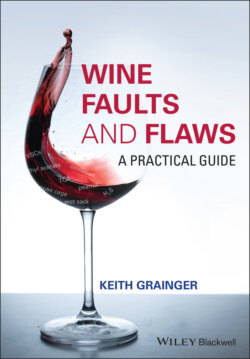Читать книгу Wine Faults and Flaws - Keith Grainger - Страница 74
2.7 Palate 2.7.1 Palate Sensations
ОглавлениеPalate is a convenient expression to describe the sensations a wine gives once in the mouth. Palate may comprise a ‘complex combination of the olfactory, gustatory, and trigeminal sensations’ [7]. In this part of the tasting process, we assess the taste and tactile sensations detected in the mouth, particularly on the tongue, and the flavour characteristics detected as a result of the wine's volatile compounds being breathed through the retro‐nasal passage at the back of the mouth and transmitted to the olfactory bulb. The impressions of aromas sensed retro‐nasally are often different from those sensed nasally. The sensory cells within the mouth are mostly contained within the 5000 or more taste buds on the tongue – young people may have up to 10 000 active taste buds. There are also taste buds on the roof of the mouth and the back of the throat, which is why some people claim to only get 100% of what the wine has to offer if they swallow rather than spit. Interestingly, a recent study has indicated that olfactory receptors are functionally expressed in taste papillae [11]. In other words, it may be possible for the tongue to ‘smell’.
A reasonable quantity of wine should be taken into the mouth. If it is too little, the wine will be diluted and modified by saliva. It is important to breathe air through the wine in the mouth to vaporise the volatile compounds. Accordingly, a free passage is needed to and from the nose to enable transmission of these aromas. If a person has a blocked nose, it is not just the sense of smell that disappears, but most of the sense of taste. The taste sensations can be increased if we breathe out via the nose after we have spat out the wine, and this action will help determine the ‘finish’ of the wine.
As we taste, chew, and dissect the wine in the mouth, before finally spitting, numerous sensations develop. This evolution is considered in stages. The initial attack is the sensation as the wine taken into the mouth. This is followed by the development on the palate where we perceive the flavour characteristics and intensity, and then the finish which comprises the final impressions of the wine including the balance. The length is a measurement of how long the sensations of the finish and aftertaste last. Tasters sometimes refer to the progressive sensations as ‘front‐palate’, ‘mid‐palate’, and ‘back‐palate’.
When assessing the palate of wine, we may consider the following headings:
Dryness/Sweetness;
Acidity;
Tannin;
Alcohol;
Body;
Flavour intensity;
Flavour characteristics;
Other observations;
Finish.
Faults that are or may be detectable on the palate are shown in Table 2.5. This list is not exhaustive.
Table 2.5 Faults detectable on palate of wine.
| Retro‐nasal, gustatory or trigeminal indicator | Possible fault | Refer to: |
|---|---|---|
| Musty, damp sack, wet cardboard | Chloroanisoles and Bromoanisoles | Chapter 3 |
| BAND‐AID® stables, animal, spicy | Brettanomyces (Dekkera) related faults | Chapter 4 |
| Burnt, bitter, dried‐out | Oxidation | Chapter 5 |
| Rotten egg, garlic, cooked cabbage, skunk | Excessive sulfur dioxide, volatile sulfur compounds, reduced aromas | Chapter 6 |
| Marmite (Vegemite), wet wool, wet cardboard | Light strike | Chapter 6 |
| Vinegar, nail varnish, solvent | Excessive volatile acidity, ethyl acetate | Chapter 7 |
| Thin body, metallic, non‐tannic bitter finish | Atypical ageing | Chapter 8 |
| Vomit | Lactic acid bacteria associated faults, (including mousiness) | Chapter 11 |
| Bacon, smoky bacon crisps | Smoke taint | Chapter 12 |
| Peanut, earthy, bell pepper (unexpected) | Ladybug (Coccinellidae) taint Brown marmorated stink bug (Halyomorpha halys) taint | Chapter 13 |
| Prunes, burnt, overcooked fruitcake | Heat damage | Chapter 14 |
